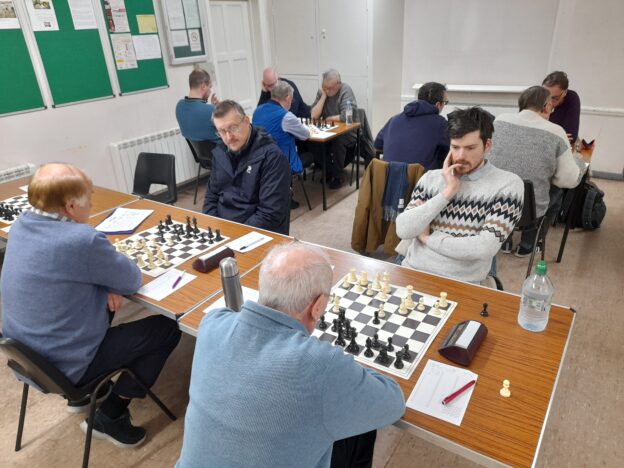Wallington v Kingston, Lauder Trophy semi-final played at Wallington United Reformed Church on 12 February 2025
This match was always going to be tense. It goes with the territory in the Lauder Trophy, where the collective rating of the team cannot exceed 10,500. How do you divide up the rating cake: two strong players and four weaker players; six mid-rated players? The puzzle always takes a lot of solving.
Wallington and Kingston went for very similar teams – two strong players and four very decent players in the 1500-1750 bracket. A close match was guaranteed and so it proved, with Kingston squeezing home by 3.5-2.5 after an evening of high drama.
On top board, veterans David Rowson of Kingston and Nick Edwards of Wallington (and indeed Coulsdon) faced each other – amazingly, so David says, the first time they have ever met in a classical game despite both being an integral part of the Surrey chess scene for more than half a century.
Nick is a very principled, positional player and opened with d4, to which David replied with an unusual King’s Indian-type line. “Nick and I had a great set-to,” says David, “which we both enjoyed, with some rather unusual positions arising from what I think is called the KID Kramer System. After the game we spent a long time analysing it, but putting it through Stockfish it seems we assessed a lot of the positions wrongly.”
This was a key position. Should Black take the pawn on h4? “Maybe I should have taken,” says David, “but it looked very risky to me.”
Alan Scrimgour had White and a hefty rating advantage on board 2, and his assured win against the very solid David Jones was vital to the Kingston cause. This was how Alan succinctly summed up the game afterwards: “Careful manoeuvring around the queenside majority combined with pressure on the IQP [isolated queen’s pawn] led to win of the exchange. My opponent, despite his time shortage, responded with a kingside sortie that White had under control.” This was the game’s denouement. White is on top, so Black decides to go for broke.
Meanwhile on board 3, Jon Eckert was defending an Exchange French. He felt it was drawish from an early stage, but there were some late complications and he had winning chances. But Jon also recognised that we probably had our noses in front in the match – with good positions with White on boards 2 and 4 – and offered his opponent a draw, which was accepted. The fact that Kingston’s players were all taking stock of the match situation was one of the great positives of this win. Chess is a very individual game, good players are often egoists, and the match context can sometimes be forgotten.
Kingston’s one reverse came on board 6, where Aziz Sannie lost to the promising Wallington junior Mohamed Nasrudeen Meeran. Aziz went the exchange (rook for knight) down and, try though he might, couldn’t generate much counterplay as his opponent liquidated to a won endgame.
On board 5 Kingston captain Ed Mospan was facing Luke Glinton in another match-up between players with almost identical ratings. Neither could establish a significant edge in a series of blocked positions and a draw was agreed. Another important result with Black for Kingston.
That left David Bickerstaff (pictured above on the right of the picture, with Ed Mospan beside him, in a previous match at South Norwood), to put the ball in the back of the net, which is exactly what he did. David had White on board 4 against the slightly higher-rated Robert Davies, but he never gave his opponent a chance with a perfect pawn storm against Black’s KIng’s Indian Defence. Here is the game which took Kingston into the Lauder Trophy final, where we will face Coulsdon, with annotations by David.
Stephen Moss, Kingston club captain


